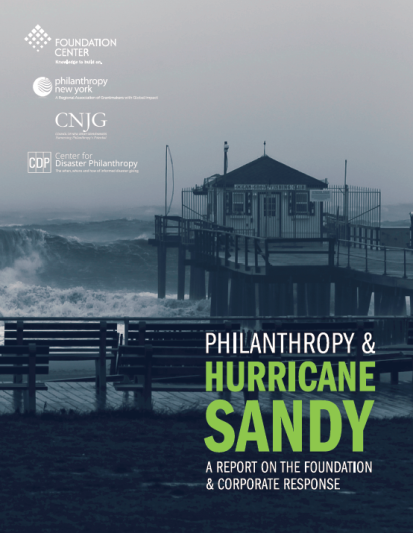Tuesday, October 28, 2014
Insights Inform Response to Future Disasters
A new report released today examines the response of foundations, corporations, and other institutional donors to the devastation wrought by Hurricane Sandy in October 2012. Numbering nearly 600, these funders have so far committed more than $380 million for relief, recovery and building efforts. The hard data and reflective observations in the report contribute to the growing body of knowledge that helps foundations and corporations be strategic and effective with their giving when disaster strikes.
Two years after the historic storm, Philanthropy & Hurricane Sandy: A Report on the Foundation & Corporate Response breaks down the allocation of dollars contributed thus far and offers perspective on the role of private giving in disaster response and lessons to be taken from this one. The report was published by New York-based Foundation Center in cooperation with the funder associations Philanthropy New York and the Council of New Jersey Grantmakers, and with support from the Washington, DC-based Center for Disaster Philanthropy.
This report notes that philanthropic donations are a small fraction of the $60 billion in emergency assistance provided by the federal government and $19 billion paid out by insurance companies. Still, the research findings reveal that philanthropy’s response has nonetheless served a critical role in certain types of relief, recovery, and rebuilding work that might otherwise fall through the cracks.
“In the wake of Hurricane Sandy, philanthropic dollars have been essential in helping community advocacy programs, filling holes in the social service delivery system, and helping community members provide input into the redevelopment planning process,” said Ronna Brown, president of Philanthropy New York. “This support is crucial to countless efforts that government often can’t or won’t fund.”
The data in the report reveal details about who provided funding and for what purposes, which organizations received support, and where funders and recipients were located. Key findings of the report include:
- Among all institutional donors, corporations accounted for the largest share of cash commitments in response to Hurricane Sandy ($136.4 million).
- Propelled by giving for immediate relief for those in the path of the storm, the largest share of support went to human services (44 percent), following by housing (11 percent).
- The national American Red Cross and its local affiliates received 23 percent of the contributions, more than any other single organization.
The report also highlights leading organizations in the region that have been important partners to philanthropy in the disaster response.
“Throughout the past two years, our exceptional nonprofit and funder community has taken on challenges they never imagined,” said Nina Stack, president of the Council of New Jersey Grantmakers. “These organizations continue to develop innovative solutions that other communities will learn from and build upon in future disasters.”
Philanthropy & Hurricane Sandy goes beyond the numbers to assess the activities of funders in this and past disasters in order to highlight “best practices.” For instance, making an effort to share information with other funders and nonprofits is cited as a particularly effective strategy in such situations. The report also identifies opportunities for funders to make a bigger impact with their contributions, such as when they can address funding gaps that remain after the initial short-term response. The observations and advice outlined in the report are designed to help funders be more strategic in their response to disasters.
“After a devastating event such as Hurricane Sandy, stress levels are high, communities’ needs are great, and preparedness is key,” said Bradford K. Smith, president of Foundation Center. “Funders will be able to use the information in this report to put practical policies in place that position them to be nimble and strategic, especially in times of crisis.”
The report analyzes giving by type of funder, by type and purpose of support, and by location of funders and recipients, and it lists the top funders and grant recipients. Two essays explore the foundation and corporate response in the hardest hit areas in New York and New Jersey.
“There will undoubtedly be more disasters in the future when private donors will be called upon to take action,” said Robert Ottenhoff, president of Center for Disaster Philanthropy. “This is an important opportunity to learn lessons that can maximize the impact of philanthropic dollars through a thoughtful examination of which practices have been most successful.”
Philanthropy & Hurricane Sandy can downloaded the report for free at Foundation Center’s website or Philanthropy New York’s site at PhilanthropyNewYork.org/SandyReport.

